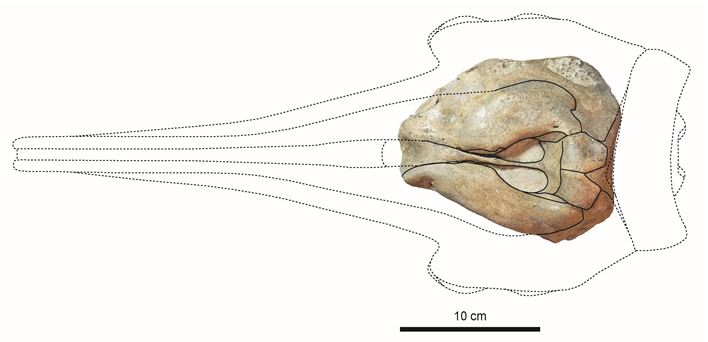Waseda researchers discover the world's oldest true dolphin species – rewrite the known fossil record

Diagram of the ancient dolphin's asymmetrical skull (by Mizuki Murakami)
In an article published in the “Journal of Vertebrate Paleontology”, Waseda Department of Earth Sciences researchers (lead author Mizuki Murakami) conclude that the specimen, which was originally categorized in 1977 as Stenella kabatensis, actually belongs to the Eodelphis kabatensis species.
This means that true dolphins existed 2 to 7 million years earlier than had been previously suggested by fossil records, and aligns with the results of molecular studies.
This work also includes the most comprehensive analysis yet of the relationships within the group of marine mammals that encompasses toothed whales such as orcas and sperm whales.
In another study, Murakami and a team of researchers also described the oldest known dolphin fossil with an asymmetrical skull, and created a new simulation of their evolution.
It has been accepted theory that dolphin ancestors earlier than 10 million years ago all had symmetrical skulls, and that asymmetry was the result of subsequent evolution. This study suggests a different evolutionary path for the marine mammals.
Media Contact
All latest news from the category: Earth Sciences
Earth Sciences (also referred to as Geosciences), which deals with basic issues surrounding our planet, plays a vital role in the area of energy and raw materials supply.
Earth Sciences comprises subjects such as geology, geography, geological informatics, paleontology, mineralogy, petrography, crystallography, geophysics, geodesy, glaciology, cartography, photogrammetry, meteorology and seismology, early-warning systems, earthquake research and polar research.
Newest articles

A universal framework for spatial biology
SpatialData is a freely accessible tool to unify and integrate data from different omics technologies accounting for spatial information, which can provide holistic insights into health and disease. Biological processes…

How complex biological processes arise
A $20 million grant from the U.S. National Science Foundation (NSF) will support the establishment and operation of the National Synthesis Center for Emergence in the Molecular and Cellular Sciences (NCEMS) at…

Airborne single-photon lidar system achieves high-resolution 3D imaging
Compact, low-power system opens doors for photon-efficient drone and satellite-based environmental monitoring and mapping. Researchers have developed a compact and lightweight single-photon airborne lidar system that can acquire high-resolution 3D…





















